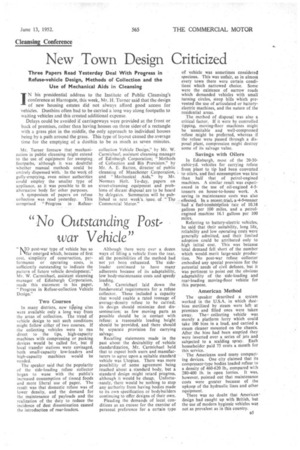"No Outstanding Post war Vehicle"
Page 39

If you've noticed an error in this article please click here to report it so we can fix it.
" NO post-war type of vehicle has so far emerged which, because of first cost, simplicity of construction, performance or operating costs, is sufficiently outstanding to indicate the pattern of future vehicle development." Mr. W. Carmichael, assistant cleansing manager of Edinburgh Corporation, made this statement in his paper, " Progress in Refuse-collection Vehicle Design."
Two Courses
In many districts, new tihing sites were available only a long way from the areas of collection. The trend of vehicle design to suit such conditions might follow either of two courses. If the collecting vehicles were to run direct to the tips, high-capacity machines with compressing or packing devices would be called for, but if local transfer stations were envisaged, both small-capacity low-loaders and high-capacity machines would be needed.
The speaker said that the popularity of the side-loading refuse collector began to wane with the public's increased consumption of tinned foods and more liberal use of paper. The result was that domestic refuse was of lower density, and the demand for the maintenance of payloads and the realization of the duty to reduce the incidence of dust dissemination caused the introduction of rear-loaders. Although there were over a dozen ways of filling a vehicle from the rear, all the possibilities of the method had not yet been exhausted. The sideloader continued to have many adherents because of its adaptability, low body-maintenance costs and speedy loading.
Mr. Carmichael laid down the fundamental requirements for a refuse collector. These included a capacity that would enable a rated tonnage of average-density refuse to be carried; its design should minimize dust dissemination; as few moving parts as possible should be in contact with refuse; a reasonable loading height should be -provided, and there should be separate provision for carrying salvage.
Recalling statements made in the past about the desirability of .vehicle standardization, Mr. Carmichael held that to expect both users and manufacturers to agree upon a suitable standard vehicle was Utopian. There was more possibility of some agreement being reached about a .standard body, but a standard design might retard progress, although it would be cheap. Unfortu,nately, there would be nothing to stop any authority from having bodies made to its own specification or bodybuilders continuing to offer designs of their own.
Pleading the demands of local conditions as an excuse for the exercise" of personal preference for a certain type




















































































